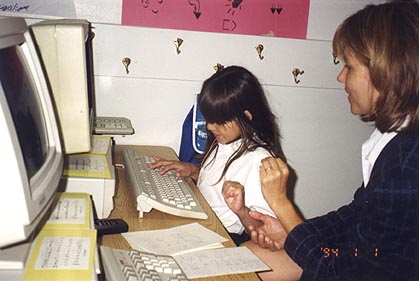|
Silent News, November 1999
page 3
Younger Children's Ability To Read SW:
"Two of the younger students (5 & 8 yrs) took to these
SW symbols (on flash cards) rather quickly. We were matching
the (SW) sign vocabulary with some pictures and illustrations
of events that might evoke some of those feelings. "The
two students seem to recognize the symbols as a whole and 'read'
these signs quickly: SCARED, EXCITED, SAD, HAPPY. The others
(older ones) in the group took the lead of the early SW 'readers',
and continued with the activity signing what their peers saw
on the flash cards. "Even (when I) was ready to move onto
another activity with the other three students, the two students
wanted to continue the activity on their own, sorting out the
SW flash cards that was piled between them matching them with
the illustrations provided." Flood and her students continued
discussing, creating and sorting out SignWriting symbols.
Middle-School Students' Reactions
"The middle school students initially were more skeptical
when I showed some samples of SW to them. I did get some comments
like; 'That's weird!', 'But that's hard to learn', 'Why should
I learn Sign Writing? I already know and have a lot of experience
using ASL'! and 'I don't want to learn that stuff, it's too hard'.
"I didn't stop there....though I was tempted. I introduced
some of those very same skeptics to the SignWriter, the sign
language word processor program. They were more interested then
and took to using the computer to generate individual signs,
then strings of signs, then whole signed comments.
 Chaparral Elementary School
in Albuquerque, New Mexico
Chaparral Elementary School
in Albuquerque, New Mexico
Classroom teacher Lorraine Crespin assists Deaf student
Monica,
who is learning to type with the SignWriter Computer Program.
Notice the SignWriting chart on the wall.

"Typical of young adolescents, their comments focusd on
what they had done
with friends over the weekend, their boyfriends, school special
events. The students pecked away at the computer keyboard with
confidence and satisfaction....." Prior to using the SignWriter,
I don't think these students paid much attention to how they
were signing. Watching two 8th graders at the library computers
discussing the palm orientation of a sign not in the dictionary,
negotiating.....was evidence enough for me to pursue the formal
initiation of an ethnographic research project. This project
will document the experiences of deaf and hard of hearing students,
ages 5- 14, (yes and even the skeptics among them) learning how
to write using SignWriting, a way to read and write signs.
What The Future May Hold:
Flood predicted, based on her observations and current research:
"Using a yet-to-be-tapped resource, signwriting, deaf and
hard of hearing students will not only become better signers,
but also better readers and writers, plus they will attain membership
in the growing club of bilingual readers and writers in the U.S.A."
Teachers can write or call for a free packet of information on
SignWriting:
The SignWriting Literacy Project
The DAC, Deaf Action Committee For SignWriting
P.O. Box 517, La Jolla, CA, 92038-0517, USA
Voice(858)456-0098...TTY(858)456-0010...Fax(858)456-0020
Email:
DAC@SignWriting.org
SignWriting Web Site:
https://www.SignWriting.org
|
